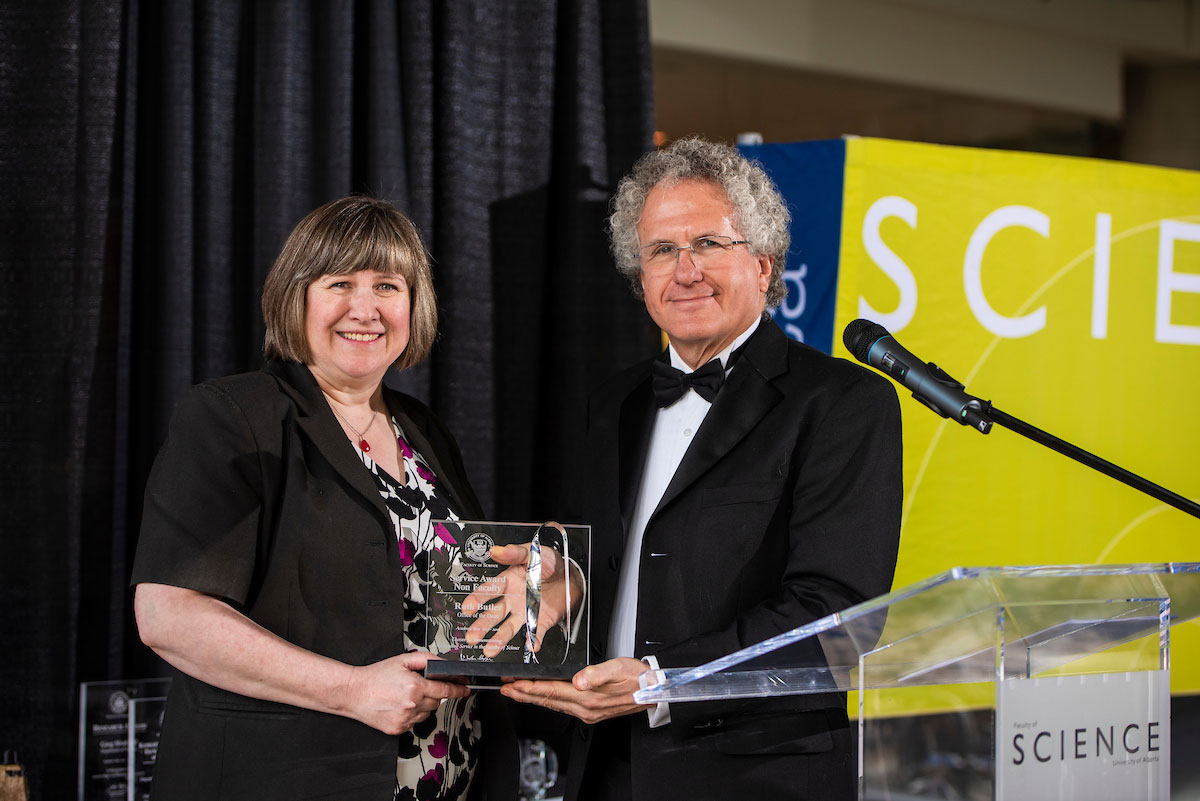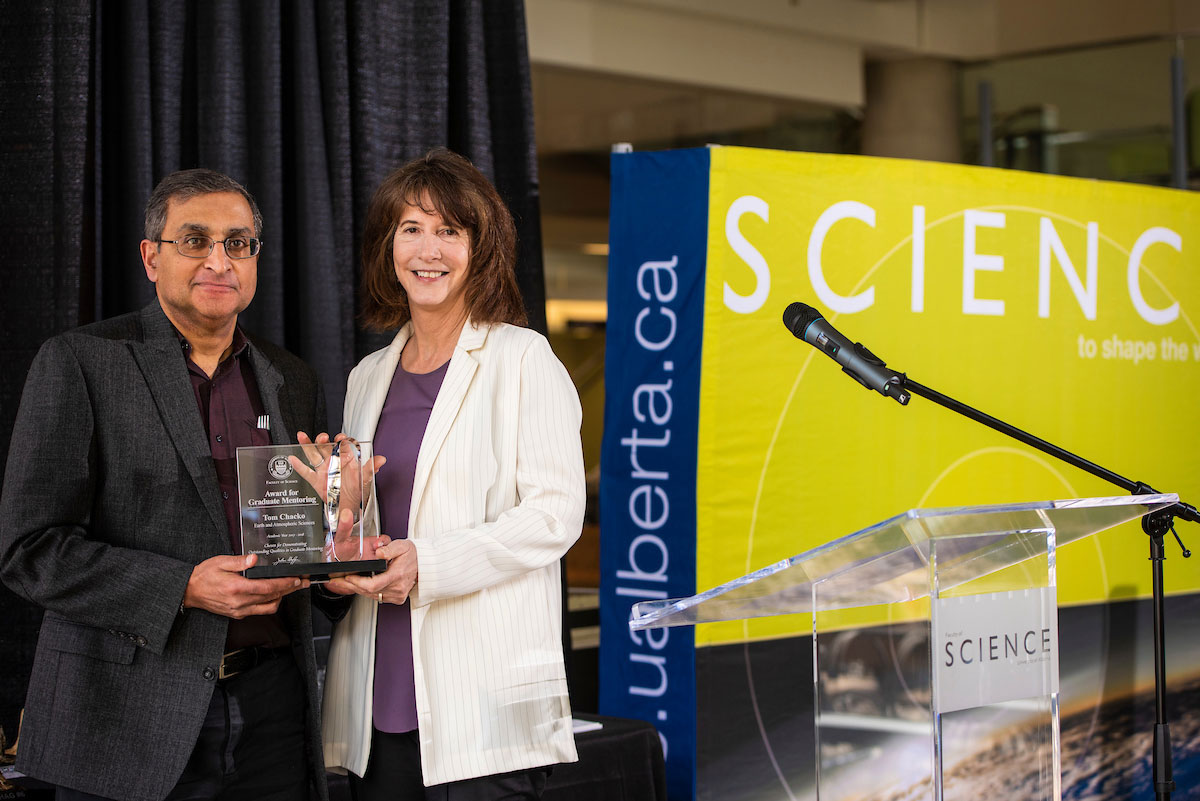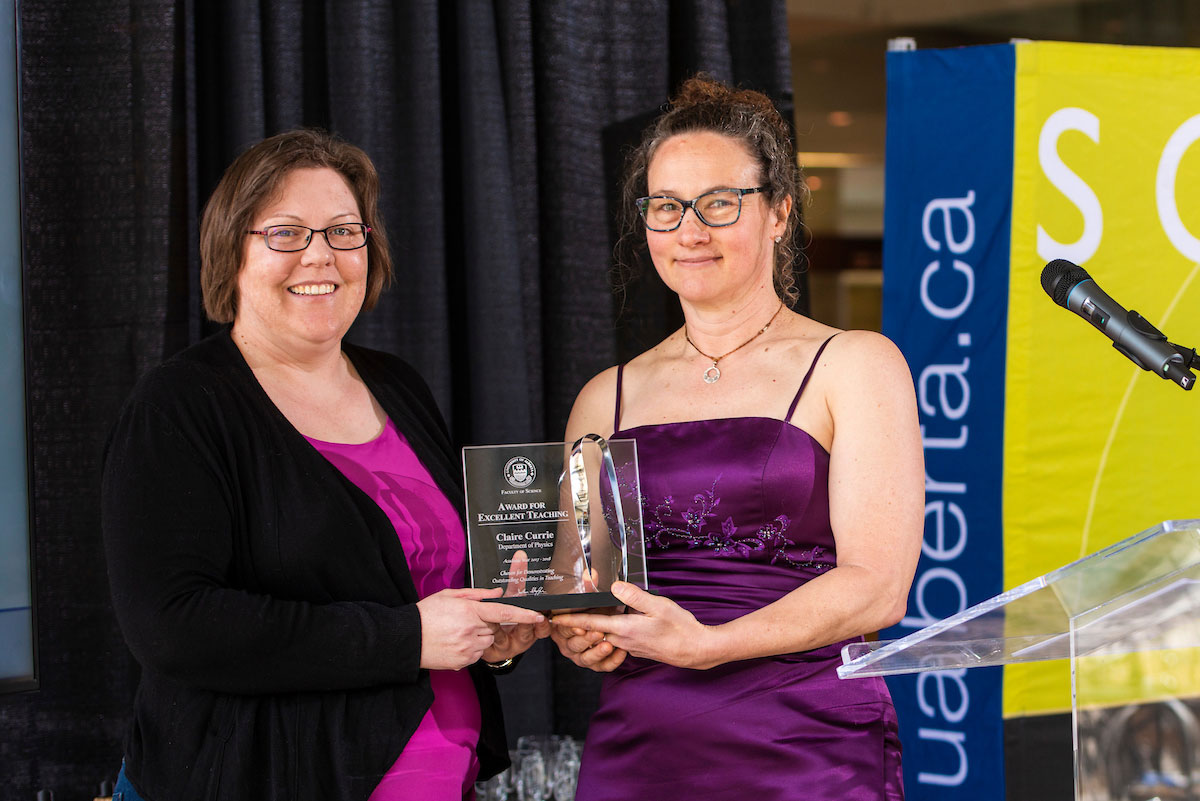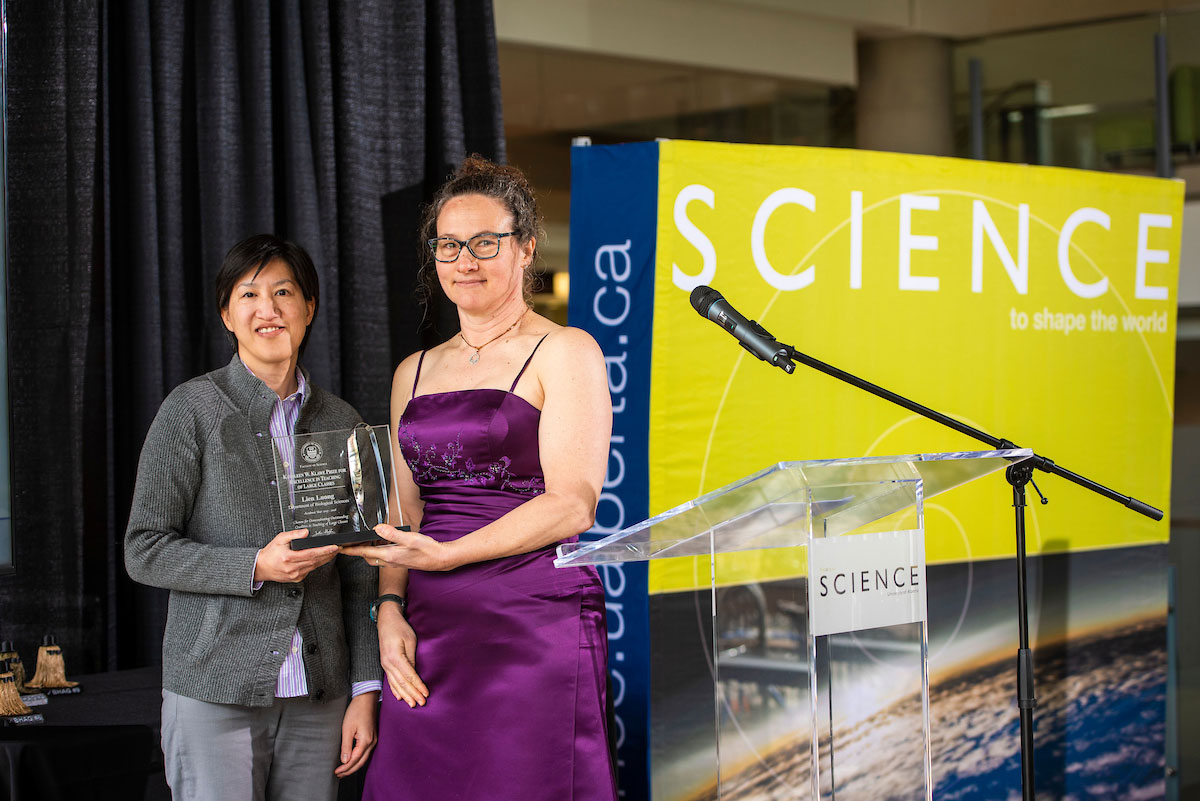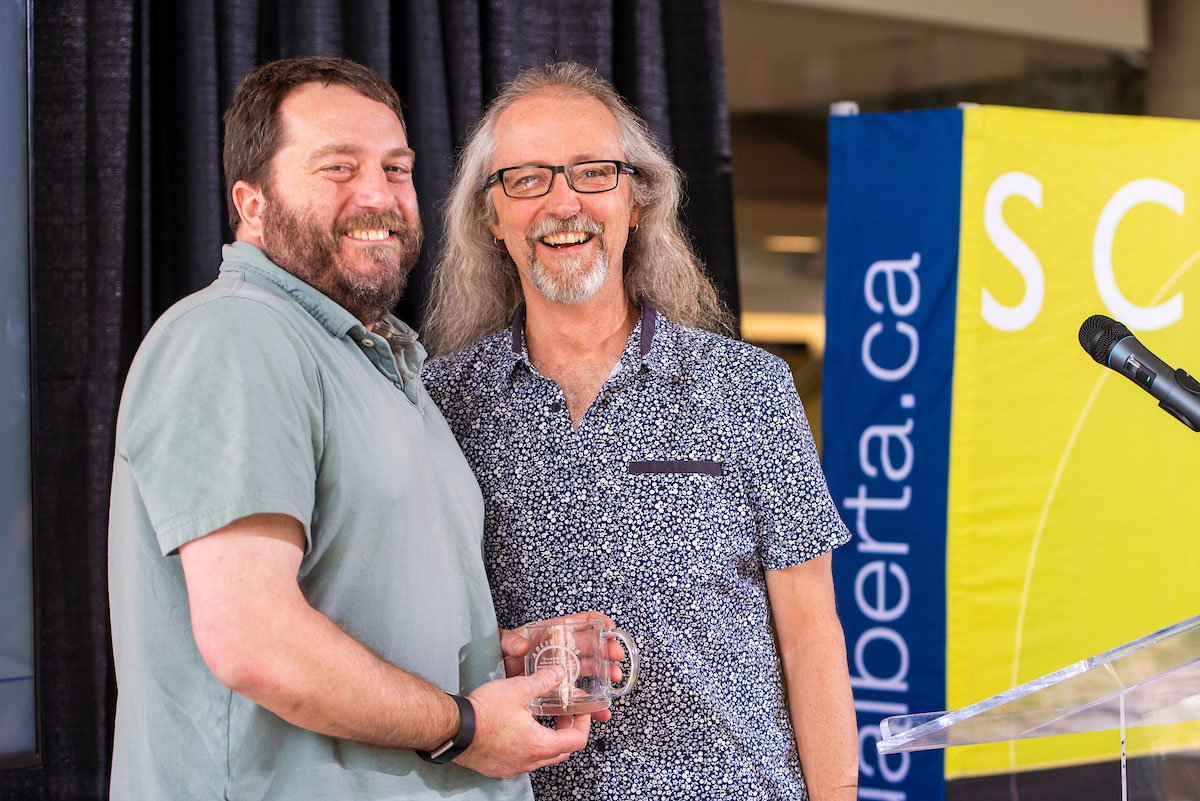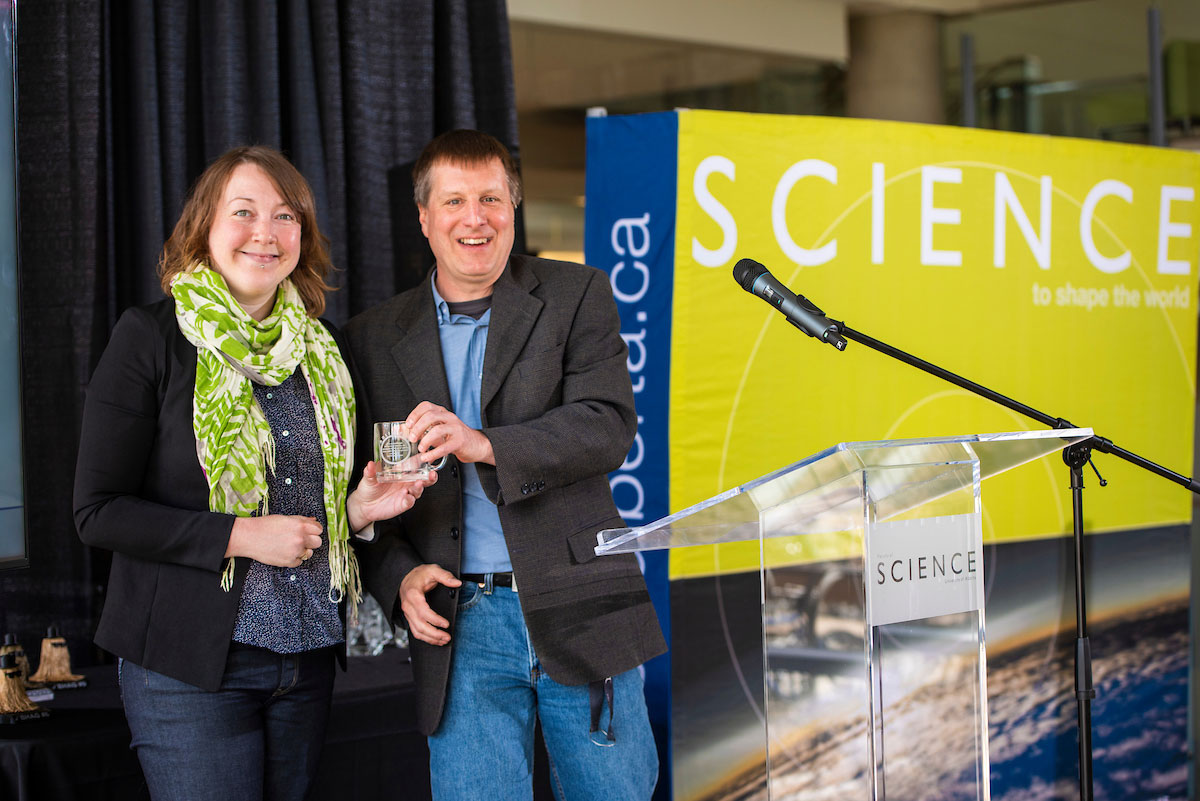Each year, the Faculty of Science hosts the Celebration of Excellence in Teaching and Research, an awards ceremony to honour and celebrate our exceptional faculty and staff.
"Thank you for your tireless efforts to engage our students, to understand the past, and to shape our collective future," said Jonathan Schaeffer, dean in the Faculty of Science. "Next month we will be sending a new graduating class out into the real world. I'm confident that we have given them a competitive advantage as they venture forth."
This year's award recipients speak to the calibre of talent in the University of Alberta's largest undergraduate faculty. Learn more about the award winners.
Quick jump to award winners:
Service Award | Research Award | Graduate Student Mentorship Award | Excellent Teaching | Excellence in Teaching of Large Classes
The Associate Dean of Learning and Innovation Besties for: Biological Sciences | Chemistry | Computing Science | Earth and Atmospheric Sciences | Mathematical and Statistical Sciences | Physics | Psychology
Service Award - Ruth Butler
The 2018 Faculty of Science Service Award honoured Ruth Butler, executive assistant to the dean in the Faculty of Science.
Butler's career with the University of Alberta began in 1988, where she started working in the Department of Physics in a temporary administrative role. In 1993, she landed a position in the Faculty of Science assisting the dean, and the next year, she was made permanent as the executive assistant to the dean.
In the 24 years since, Butler has served three deans, providing complex and diversified administrative functions, helping steer the faculty through turbulent times and has done so with professionalism, passion, and dedication that is deserving of this service award.
The role of an EA is like that of a triage nurse in an emergency room. Situations come in on an hourly basis, and the EA must quickly assess the need, urgency, and route to appropriate action. Butler's ability to think critically and calmly to analyse information effectively is absolutely essential in keeping the Dean's office running smoothly and efficiently.
Research Award - Gregory Sivakoff
The recipient of the Faculty of Science Research Award this year was Gregory Sivakoff, associate professor in the Department of Physics.
In the words of his chair, Mauricio Sacchi, and colleague, Associate Professor Sharon Morsink, Sivakoff has made a significant impact in the field of astronomy and has become a highly respected international leader in the observational study of black holes, neutron stars, and white dwarf stars, known as compact objects.
In the seven years since joining the University of Alberta, he has co-authored 65 refereed publications, including 8 papers led by his graduate students as well as works with major international collaborations.
As an observational astrophysicist, one of the most important factors for doing great research is obtaining time on major telescopes, allocated through a process similar to granting of research grants. Sivakoff and his students' time on international observational facilities is a testament to both the excellence of the science he proposes as well as his reputation.
Additionally, Sivakoff is an incredibly selfless researcher who has a deep commitment to service, to his department, to astronomy within Canada and worldwide, to mentorship of a new generation of scientists, and also to the general public.
Graduate Student Mentorship Award - Tom Chacko
The recipient of this year's Graduate Mentoring Award is Tom Chacko, from the Department of Earth and Atmospheric Sciences (EAS).
This award is special because it is the graduate students who decide on a departmental nominee and who prepare the nomination, soliciting letters from both current and former students. And EAS grad students did a superb job in preparing their nomination material, demonstrating the many ways in which Chacko goes beyond being an outstanding supervisor to being an outstanding mentor.
The nomination material conveyed very clearly that Chacko instills a love of science in his trainees and critically, a confidence in themselves as researchers-leading some students to pursue a graduate degree when they had never considered that path for themselves, and others to persevere with their programs when facing difficult challenges and obstacles. It also describe how Chacko routinely and proactively pursues opportunities beyond his lab for his students, opportunities that students say left them better scientists and with professional connections that helped them in their future careers.
One letter remarked that Chacko simply cares deeply about graduate students, with another letter detailing the ways in which he has worked to ensure that all graduate students, regardless of subdiscipline, have the tools they need to succeed personally and professionally with their programs.
And finally, Chacko clearly sees his mentor role as a lifelong commitment. Two former students took the time to describe how he has continued to be an essential source of advice well after they graduated, offering insights into all aspects of the life of a young professionals.
And a third former student closed by noting, "For the young scientists I'm now privileged to supervise, I strive to be as supportive and enthusiastic of a mentor as Tom was to me"
Excellent Teaching - Claire Currie
The 2018 recipient for the Excellent Teaching award is Claire Currie, associate professor in the Department of Physics.
In the words of her Chair, Mauricio Sacchi, Curriehas dedicated a decade to not only outstanding teaching but also a plethora of other student-related and outreach activities.
She has frequently received a perfect 5.0 on her teaching evaluations, with overwhelmingly enthusiastic comments from her students. Mauricio notes that we would be hard-pressed to find an instructor with such a consistently outstanding student response.
Currie has taken on the challenging role of teaching combined Physics and EAS courses, achieving levels of success and popularity never experienced before in this quote-unquote "hard to teach" class situation.
In addition to her fantastic teaching in a challenging environment, Currie's involvement in outreach has been continuous and impressive. She is an incredible representative for women in Physics and an active and encouraging role model for young women in geophysics, addressing gender balance, diversity, and inclusion, with efforts to attract undergraduate and graduate female student to the geophysics program.
Excellence in Teaching of Large Classes - Lien Luong
The Kathleen W. Klawe Prize for Excellence in Teaching of Large Classes this year goes to Lien Luong, Assistant Professor in Biological Sciences.
In the words of Jocelyn Hall, associate chair (undergraduate) and Chair Michael Caldwell, Luong is an enthusiastic and engaged instructor, who successfully brings a range of innovative techniques to teaching large classes.
An expert in the ecology and evolution of host-parasite interactions, Luong teaches one of biological sciences' largest courses-an introductory course on biological diversity-with between 250 and 400 students per lecture session.
What makes Luong stand out as an instructor of a large class is her varied approach in teaching a class of this size, ensuring her advanced approach is dedicated to increasing students' understanding of concepts to foster independent study. Students recognize the value of her focus on striving to help them understand biology, and their response to her teaching is overwhelmingly positive, a sentiment echoed by her peers.
Luong inspires other professors, both new and senior, to try new approaches of conveying difficult material or encouraging student engagement. What seems to resonate most for students in Luong 's large classes is that she cares about them, their success, and their engagement.
Lien's dedication is best summed up with this comment from one of her students: "She is a gift to not only the U of A, but to every student she teaches."
ADLIBs Awards
This year, our associate dean of learning and innovation, Elena Nicoladis, created a new award category, the ADLIBS, or the The Associate Dean of Learning and Innovation Besties.
Nicoladis asked each department to identify an instructor that embodied the following quote by Carl Friedrich Gauss in their teaching: "It is not knowledge, but the act of learning, not possession but the act of getting there, which grants the greatest enjoyment."
Here are the first-ever ADLIB award recipients.
Biological Sciences - JC Cahill
When JC Cahill teaches, he does everything wrong according to conventional wisdom. He does not post his lecture notes online. He does not evaluate students simply on their memorization of the material that he presented.
Instead, Cahill designs his courses to engage students in what we do not yet know. Cahill's ultimate goal is to teach students how to generate ideas and evaluate information, and thus teach them all how to do science. He lectures by asking questions, leading students to question their own assumptions and what they thought they knew. A class with Cahill is a dialogue between instructor and students, emphasizing unresolved problems rather than undisputed truths. Of course, a Socratic style requires a special mixture of knowledge and stage presence, and Cahill is not only a well-versed ecologist, but articulate, witty, animated, and above all, enthusiastic.
Evaluations of learning in his classes include essay-only lecture exams. Before the exam, students get a list of 5-10 essay questions. The in-class exam consists of three of these questions, for which they need to write a one-page essay to each. Prior to the exam, he emphasizes these are open-ended questions with multiple correct answers, and encourages students to discuss the questions with classmates.
He also has a very open ended project that encourages students to present ecological concepts to a non-scientific audience. Students present boardgames, podcasts, and more. In BOT 332, a field trip to Dinosaur National Park leads to students designing their own projects to test in the lab.
Most students respond very positively to an opportunity to think rather than memorize, stating how engaged and thought provoking this format can be. Many students recognize that it encourages greater student engagement in class and inspires them to take greater ownership of their own learning.
As one student said: "JC manages to weave an interesting narrative into every lecture and makes the material engaging and relevant to current events. He knows what he wants to teach us but it in a way where we are nudged with hints and evidence so that it feels like I'm the one making the
connection in my head...what a satisfying way to learn. I wish all of my lecturers could pull that off."
Chemistry - Sarah Styler
Sarah Styler has developed for CHEM 305 a student-led air quality monitoring project conducted with the AirBeam particulate matter monitor, a small, low-cost citizen science instrument for measuring the concentration of fine, inhalable particulate matter, also known as PM2.5.
In the project, the students work in small groups examining the primary literature, developing a testable hypothesis using the AirBeam sampler, designing and undertaking the experimental measurements, and finally presenting their findings as both a talk and a journal-style article.
As students are involved in all aspects of the project from conception to completion, they get to experience the highs (and lows) of putting their theoretical knowledge developed in the course into practice. This project is not just a "cookie cutter" laboratory experiment but rather one that takes the students on a scientific journey.
Projects undertaken by the students in Winter 2017 included studies on air quality in public transit, impact due to secondhand smoke, and, in a topic highly-relevant to those of us working just outside a construction zone due to the ongoing renovations in Chemistry West, at an indoor construction site. In Winter 2018, students proposed and conducted an entirely new slate of projects, including measurement of PM2.5 levels in nail salons, a charcoal barbecue restaurant, a recreation centre swimming pool, and U of A's climbing gym.
Clearly, there are a broad diversity of projects, where the experimental measurements take place outside the controlled confines of the typical research laboratory and where the experimental constraints are much more variable than students would encounter within an undergraduate laboratory designed for a course. Moreover, students see and understand first-hand how basic scientific measurements, of their own design, are connected to the community and world around them.
An article on the project, with third-year U of A engineering student Sherry Gao as first author and in collaboration with faculty at MacEwan University, has just been published in the educational research section of "Analytical and Bioanalytical Chemistry", and the project concept has also been adapted for use in the Department of Chemistry at the University of Syracuse.
Computing Science - Abram Hindle
Abram Hindle is not your usual software engineering professor. He does not just lecture and assign work. He likes to use valuable class time for other modes of learning because it is "the act of learning" and "the act of getting there" that is most important.
First, Hindle uses valuable class time to do fun, formative class quizzes, which is atypical for a computing science class. Normally, we like to load up the students with knowledge, as if they are trekking to the South Pole, wish them well, and hope to see them back safe and sound at deadline time. Or not.
A student from CMPUT 301 (Introduction to Software Engineering) says, "The in class quizzes were very helpful in making sure that I understood everything." That feedback from a student, about a quiz, is also highly atypical. Of course, many courses use quizzes. However, Dr. Hindle's quizzes are far from the static and multiple-choice assessments of the past. His quizzes require thought and he has a variety of them.
As another example, the pair programming quiz has two students in the class write a program in class. This is challenging, but made doable with the use of 2-person teams (aka pairs), which also happens to be how a lot of programming is done in industry. As one student notes in relation to Dr. Hindle's class activities, "Well constructed, accurate, and formulated to match real world industry practices." And another student noted, "This course is very helpful for working in industry. Definitely helped me feel more confident about my future career."
There are other innovative touches like: "After a quiz he would then have students come up to the front to help him in the explanation of the quiz. This not only helped improve class participation but also helped cement concepts and their understanding", noted an appreciative student. Dr. Hindle's classes are far from the passive lectures of the past.
Second, Dr. Hindle made videos to help students learn the material. His 5-hour video on developing an Android application from scratch was unexpectedly popular. On the one hand, a 5-hour video would not be expected to be popular since that is about the length of half a Lord of the Rings movie marathon. On the other hand, student comments and letters often refer to the usefulness of the videos and the access logs of the videos show that they are popular, especially around due dates.
Admittedly, quizzes and videos are not new to many courses. However, the way the students in CMPUT 301 respond to these elements is nothing short of impressive. What used to be a fairly passive class has become an active, participatory class that most students value.
Earth and Atmospheric Sciences - Theresa Garvin
Geographershave long been noted for making pathways into unchartered territory. Theresa Garvin and Leith Deacon have demonstrated that geographers are still leading the way off the beaten path, even in the 21st century. Theresa Garvin had the original inspiration to revamp an important introductory Human Geography and Planning (HGP 100) course, a course that commonly requires teaching of large numbers of students (up to 240 students per section). Theresa put in a lot of work toward the redesign before Leith Deacon joined in to help. They replaced the traditional lecture-only format with a three-pronged approach: a mix of online learning, activity-based seminars and traditional lectures. By presenting the material in multiple formats, students report that they feel like they are getting converging evidence toward understanding the material, that they can go deeper into their understanding.
The transformed course delivery has included the development of new course content. For example, in Week 6 students examine borders and boundaries. To encourage lateral thinking, students read a poem (Robert Frost's Mending Wall), which raises questions about the nature of a boundary. In lecture, political boundaries are problematized. In seminar, students experience arbitrary boundaries and must make decisions about how to deal with these in situations of potential conflict.
Theresa and Leith have exploited the online medium to address some critical challenges in teaching some material. For example, instructors had noted that over the years, students have struggled with two important geographical concepts: distance decay, and central place theory. Working with CTL, they wrote and animated two video shorts that explain these concepts. Students can view these videos as many times as needed to grasp the concepts.
The weekly seminars (in groups of 20-30) with both the instructor and a TA have had a big impact on students' engagement. The seminar activities push students to think more deeply and critically. For example, in one seminar activity, students are exposed to the concept of full-cost accounting and the relationship to petroleum products. In this exercise, students track the "full cost" associated with a petroleum product from cradle to grave including production, refinement, shipping, and disposal. Students become more critical of products and have a more thorough understanding of the importance of employing a long-term perspective when deciding on product purchase and development.
In addition to learning from these connected-to-real-life activities, students learn by collaborating with their peers. In doing so, students experience less culture shock to what can seem like a faceless and uncaring university learning environment.
The revision of HGP 100 has yielded impressive results. The number of students
continuing on in the Human Geography program has increased significantly since the
implementation of the blended learning environment in HGP. Our Human Geography and Planning faculty speak to how much better the revised HGP 100 course now prepares Geography and Planning students for their more senior courses. And the students feel "prepared to take on higher level Human Geography and Planning courses" but as importantly, they now see their time in HGP 100 "as a memorable period in their careers as undergraduate students at the University of Alberta".
Mathematical and Statistical Sciences - Shawn Desaulniers
Eduardo Galeano once said: "Utopia is on the horizon. I move two steps closer; it moves two steps further away. I walk another ten steps and the horizon runs ten steps further away. As much as I may walk, I'll never reach it. So what's the point of utopia? The point is this: to keep walking."
Absolute knowledge is utopia. The real point of education is the walk, the act of learning.
No one understands this better than Shawn Desaulniers. His dedication to the process of learning is phenomenal. It shines in everything that he does: from teaching undergraduate courses, to training young instructors, to tutoring high school students, to organizing outreach mathematics activities with First Nations. His teaching philosophy is student-centred, rooted in active learning. He is absolutely passionate about sharing his enthusiasm for the art of actively doing mathematics.
A few examples. This year, Shawn co-organized a brand new two-day teacher training workshop for postdoctoral fellows in the Department of Mathematical and Statistical Sciences, which should become an annual or bi-annual event. He took it upon himself to rethink some of our first-year course offerings, and apply for a blended learning fellowship from the Centre for Teaching and Learning. He started developing crucial relationships with the Maskwacis school board (Maskwacis is a First Nation community south of Edmonton). He brings high school students to campus three days a week to do mathematics. He is currently planning a new mathematics summer camp for First Nation high school students in the Edmonton urban area. He is actively involved in discussions and collaborations to improve the online assessment platforms that we use widely in our course offerings, to further enhance students' learning process. He invites visitors to speak on teaching and learning, in collaboration with the Faculty of Education. All this on top of his standard teaching and service load, which he performs flawlessly.
And what is even more remarkable is that Shawn is a new faculty member, who joined us last July! This is his first year working here at U of A. In fact, he moved to Edmonton in early July, and in his first week here he was already co-leading a campus visit for a Mathematics summer school for students from the Maskwacis Cree Nation! Talk about diving in head first!
The level of his involvement in all aspects of teaching and learning his exceptional. He brings a fresh, new approach to teaching in the Department of Mathematical and Statistical Sciences, which certainly does not go unnoticed, both by his peers and the students who have the chance to work with him. His energy is contagious. His dedication is exemplary.
If utopia is on the horizon, then being around Shawn makes you want to walk. And most importantly, it makes you enjoy the process of walking. And see in it the true beauty of learning.
Physics - Frank Marsiglio
For the past several years, Frank Marsiglio has used a completely new approach to teaching Quantum Mechanics at the third and fourth year level: using computers to numerically solve problems. Marsiglio received a TLEF in 2012 to redesign these courses from the ground up. He now uses matrix mechanics which was originally developed by Heisenberg, a completely different, but mathematically equivalent, approach to the traditional "wave mechanics" approach. This approach has not only let students solve problems which are far more complex than they can do via the traditional approaches but has also greatly improved their computational skills.
While students are taking Marsiglio's courses, they complain. A lot. They grumble about the insanely heavy workload. They bemoan being required to think about quantum mechanics from a new perspective. They repeatedly exclaim, "It's so hard!" Sometimes they say "difficult" instead of "hard".
By the time students finish Marsiglio's courses, the song changes. Students rave about how much they have learned. They understand that they have not just mastered the course material, but knowledge that they can apply to other courses. One student encapsulated the experience of taking a course with Frank: "I have yet to meet a single other professor who asks so much of us, and yet is so well loved....His assignments often frustrate us to no end, and yet we are gluttons for punishment because he is such a good teacher." Another student, having realized the point of the heavy workload, said, "He refuses to give us easy problems, he gives us good answers, but more importantly he gives us good questions."
Frank is the epitome of an excellent, old-school physics professor. He uses neither gadgets nor gimmicks. He teaches good physics with all its pain and beauty. He teaches from his heart, with passion for his work and for his research. He infects students with his enthusiasm. Frank often lectures without notes, allowing students to follow the process of solving problems in real time. He is meticulous in presenting concepts and always crystal clear. His lectures are infused with a humble, almost self-deprecating humor that is just a natural part of Frank's charm.
Marsiglio's excellence in teaching does not stop in the classroom. He is generous with his time and attention. He lights up when he is asked a question, thrilled at an opening to explain more, to explain further. No-one ever feels embarrassed to ask Marsiglio a question, no matter how silly it may seem. This really gets students to open up to Frank, and removes one of the great impediments to learning advanced physics generally.
I leave the last world to a student: "In the bizarre and intimidating world of my first quantum class, Dr. Marsiglio built a sandbox, and suddenly the Hamiltonian wasn't an intimidating equation I needed to solve, it
Psychology - Michele Moscicki
Michele Moscicki embodies the joy of learning. Her lectures are engaging and full of concrete examples. She makes the link between dry and obscure psychological constructs and real life, either by telling stories or by showing videos. She gives analogies to make abstract genetic concepts clear and memorable. She often uses iClicker questions that serve several purposes in her classes: they help both Moscicki and the students assess how well students understand the concepts, they reinforce and illustrate concepts in and of themselves, and they elicit students' opinions.
One student summed up the experience of being in class with Moscicki: "She managed to even make the most boring parts of the course interesting and fun to learn". Another said, "Michele is an excellent teacher, and of all the profs I've had, probably the only one that could ever manage to keep me not only awake, but engaged during a 3 hour night class."
Moscicki puts a lot of thought and creativity into her assignments. Intro Psych exams consist of questions that force students to not simply regurgitate but apply their knowledge. In more senior courses, she asks students to do in-class worksheets to assess their own knowledge. For many years, she has taught a third-year topics course on the psychology of stress. In that course, she asks students to create a "stress-busting workbook" or a workbook that offers evidence-based tips on how to deal effectively with stress. She also offers celebrated in-class stress-reducing activities. Students rave about both the topic (because they feel so stressed daily) and the approach (in which they learn practical knowledge about how to deal with the stress).
Moscicki connects with students, making them feel seen and respected. Students talk about having made decisions about whether to go into psychology based on individual meetings with her. One student said, "she genuinely cares about students' well-being and respects students a lot". Another: "She really wants her students to come away from the course with more than just a memorization of terms."
Moscicki has been hired away from the UofA to that other university north of the river. She will leave a big hole in the psychology department.
Last student comment: "Michele loves teaching & you can tell!"
